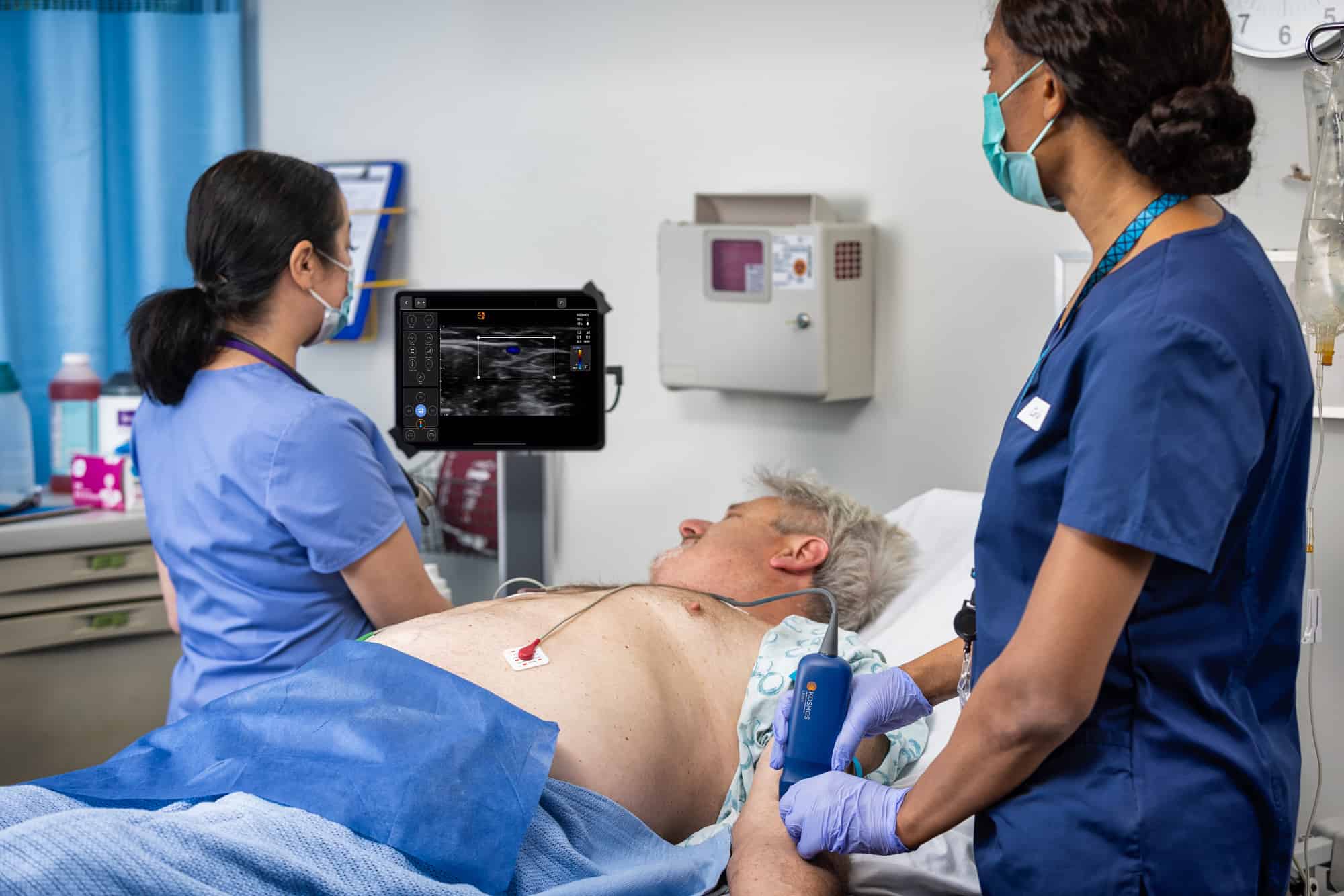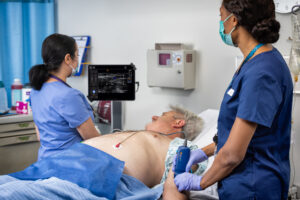Nailing a Tough Stick: A Nurse’s Guide to Modern Vascular Access Technologies
In today’s demanding healthcare environment frontline nurses, especially those needing to place IVs in patients, face numerous challenges.
Chronic understaffing, burnout, and the need to manage difficult populations are just a few of the stressors that can make an already tough job even tougher. Added to these, for nurses doing IV placements, the challenge of a “tough stick”—a patient with difficult venous access—can be one of the most daunting tasks during their shift.

However, with the advent of ultrasound for IV insertion and other modern technologies, nurses now have powerful allies in making these procedures more accurate, efficient, and patient-friendly. And, having more nurses trained and fluent in ultrasound-guided IV (USGIV) is a benefit for PICC (Peripherally Inserted Central Catheters) teams, themselves already experts in ultrasound-guided IV placements. A higher percentage of frontline nurses trained in USGIV means PICC teams get fewer calls for difficult venous access patients.
This guide explores how POCUS (Point-of-care ultrasound) is transforming vascular access while also addressing the importance of maintaining the “patient-centered” aspect of nursing in an increasingly high-tech world.
A True Game-Changer: Ultrasound-Guided Vascular Access
If your nursing practice is not currently utilizing POCUS, you might be missing out on a range of benefits that could make your job easier and more rewarding.
POCUS – particularly ultrasound-guided vascular access – has become a game changer in managing difficult IV insertions and other vascular access procedures.
Without POCUS, nurses may struggle with multiple needle sticks, causing increased patient discomfort and frustration for both the nurse and the patient. This can be especially challenging in cases where patients have difficult venous access due to conditions like diabetes, chronic illness, complex vascular anatomy, or previous IV drug use [1].
Ultrasound-guided vascular access has revolutionized the approach to challenging cases, particularly when it comes to patients with difficult venous access [1].
For PICC teams, these tools are invaluable. Vascular access ultrasound enables the visualization of veins in real-time, leading to more precise catheter placements, fewer attempts, and reduced risk of complications [2].
However, as these technologies become more integrated into nursing practice, some nurses worry that reliance on high-tech tools could extend them beyond their patients. This concern reflects a broader anxiety about how technology might alter the dynamics of nurse-patient relationships.
Addressing the Challenges of Modern Nursing
The reality of modern nursing is that it’s not just about technical skills – emotional resilience, compassion, and a sense of personal accomplishment are equally important.
Unfortunately, many nurses today are struggling with burnout, depersonalization, and lack of support. For these reasons, the idea of adopting new technologies like ultrasound for IV insertion can seem daunting.
Many nurses feel they don’t have the time or energy to learn something new, especially when they are already stretched thin. However, it’s essential to view these tools not as an added burden but as a means of lightening the load.
Using the Kosmos Lexa linear ultrasound probe for guiding IV and vascular access procedures can save time and reduce the strain on nurses. Successfully navigating a tough IV insertion or placing a catheter on the first attempt is not just a technical victory – it is a moment of connection with the patient, a demonstration of skill, and a reaffirmation of why you became a nurse in the first place.
Rediscovering the Joy of Bedside Nursing
One of the most significant benefits of integrating POCUS into a nursing practice is the potential to rediscover the joy of bedside nursing.
For many nurses, the constant pressures of modern healthcare – ranging from administrative tasks to staffing shortages – have taken the focus away from patient care.
POCUS, particularly when using a tool like the Lexsa, allows nurses to spend more time at the bedside, providing hands-on care that can be both personally rewarding and deeply impactful for patients.
Balancing High-Tech with Patient-Centered Care
While it’s natural for nurses to feel apprehensive about new technologies, it’s important to recognize that tools like vascular access ultrasound are designed to enhance, not replace, the human connection in nursing. In fact, these technologies can free up more time for nurses to engage meaningfully with their patients.
Moreover, US-guided vascular access tools are designed to complement the nurse’s skills and judgment, not to replace them. By streaming the technical aspects of vascular access, these technologies allow nurses to focus more on the patient’s overall well-being, preserving the “patient-centered” care that is crucial to nursing [3].
Improving Patient Outcomes with Vascular Access Ultrasound
The integration of vascular access ultrasound has been shown to improve patient outcomes significantly.
According to Reeves et al. [3], fewer needle sticks, reduced pain, and lower complication rates are just a few of the benefits that this technology brings.
For patients with chronic conditions requiring frequent vascular access, these improvements can greatly enhance their quality of life.
Nurses who have embraced ultrasound for IV insertion report that they can perform their duties more efficiently while maintaining a high standard of care. By reducing the physical and emotional stress associated with difficult procedures, US-guided vascular access helps create a more positive experience for both the nurse and the patient.
The Vascular Access Management and Care guide highlights that using ultrasound guidance reduces the risk of infection and complications, leading to safer and more effective patient care [2].
The data generated by ultrasound-guided vascular access can be used to track patient outcomes and identify areas for improvement. This information is invaluable for nursing leaders focused on continuous quality improvement and patient safety.
Overcoming Concerns About High-Tech Nursing
For nurses who are hesitant about incorporating high-tech tools into their practice, it is crucial to address these concerns and provide reassurance that technology will retain the human aspects of nursing.
Education and training are key in this process. By becoming familiar with vascular access ultrasound and understanding how it can enhance their practice, nurses can overcome their fears and embrace the benefits these tools offer.
Nursing leaders can support this transition by fostering an environment where nurses feel empowered to ask questions and express their concerns about new technologies.
Providing hands-on training, offering continuing education opportunities, and sharing success stories from peers who have successfully integrated ultrasound-guided vascular access into their practice can help alleviate anxiety.
It’s also important to emphasize that the use of ultrasound for IV insertion does not replace nurses’ critical thinking or compassionate care. These tools are designed to support nurses in their decisions, making them more confident in providing more precise and personalized care.
By viewing technology as an ally rather than a threat, nurses can enhance their practice and maintain the “patient-centered” care that defines their profession.
Embracing the Future of Ultrasound Guided Vascular Access in Nursing
As healthcare continues to evolve, the integration of advanced technologies like ultrasound is inevitable. By embracing US-guided vascular access technologies, nurses can streamline procedures, reduce patient discomfort, and spend more time focusing on the holistic needs of their patients.
Rather than creating distance, these tools can bring nurses closer to their patients by allowing them to deliver care that is both high-tech and deeply compassionate.
Nursing leaders have a key role to play in guiding their teams through this transition, ensuring that nurses are equipped with the knowledge and skills they need to use new technologies confidently.
By implementing a culture of continuous learning and open communication, nursing leaders can help their teams navigate the challenges of integrating high-tech tools while preserving the essential “patient-centered” aspect of nursing.
Ultimately, the balance between this recent technology and human connection is not only achievable but also essential for the advancement of nursing practice.
If your team is seeking to elevate your vascular access program, check out the Kosmos Vascular Access Bundle. This solution has everything you need for Ultrasound-Guided Vascular Access applications, including a Kosmos Lexsa probe, large iPad, and medical-grade stand, all at an incredibly competitive price under $12,000. Kosmos does not have any subscription fees, and we offer assurance with our effortless 5-year warranty.
Ready to transform your practice’s vascular access success? Schedule your demo today and see the difference Kosmos can make in patient care and outcomes.
References
- Schoch, M., Bennett, P. N., Currey, J., & Hutchinson, A. M. (2020). Point‐of‐care ultrasound use for vascular access assessment and cannulation in hemodialysis: A scoping review. Seminars in Dialysis, 33, 5, 355-368).
- Parisotto MT (2018). Vascular Access Management and Care: A Nursing Best Practice Guide for Central Venous Catheter.
- Reeves T et al.. (2017). A Nurse-Led Ultrasound-Enhanced Vascular Access Preservation Program.



